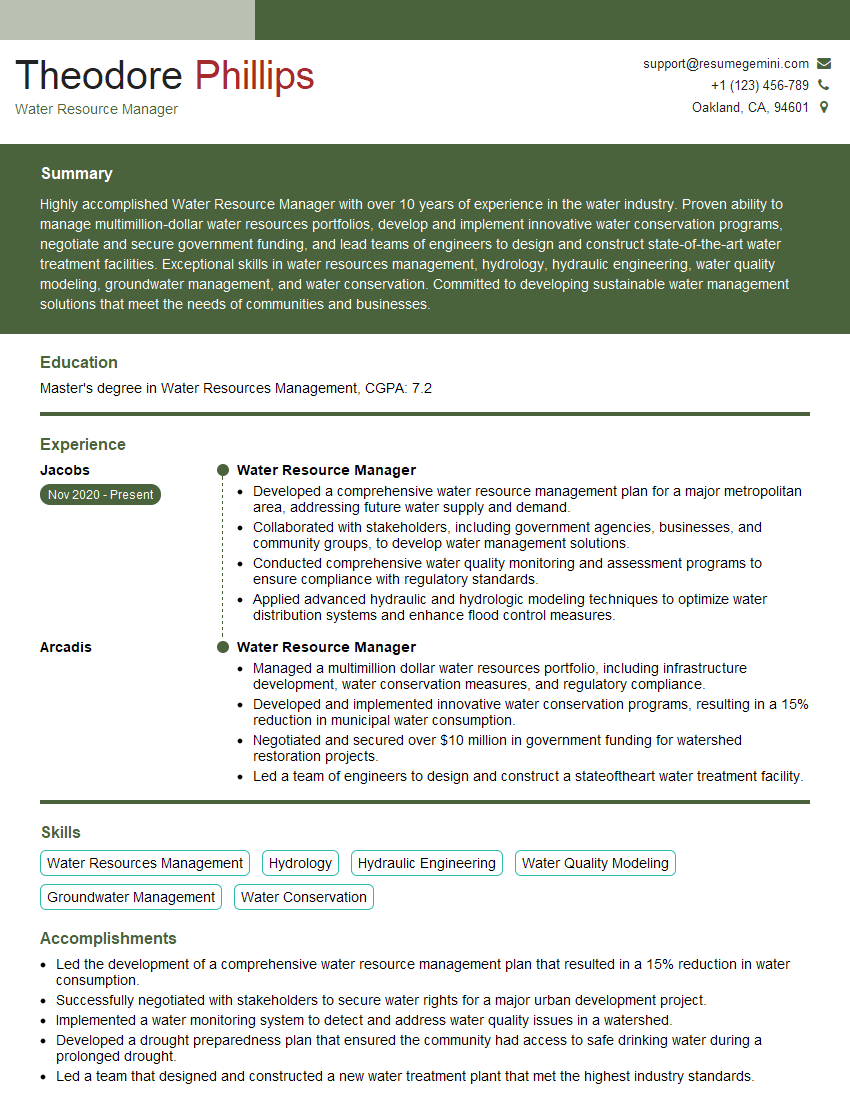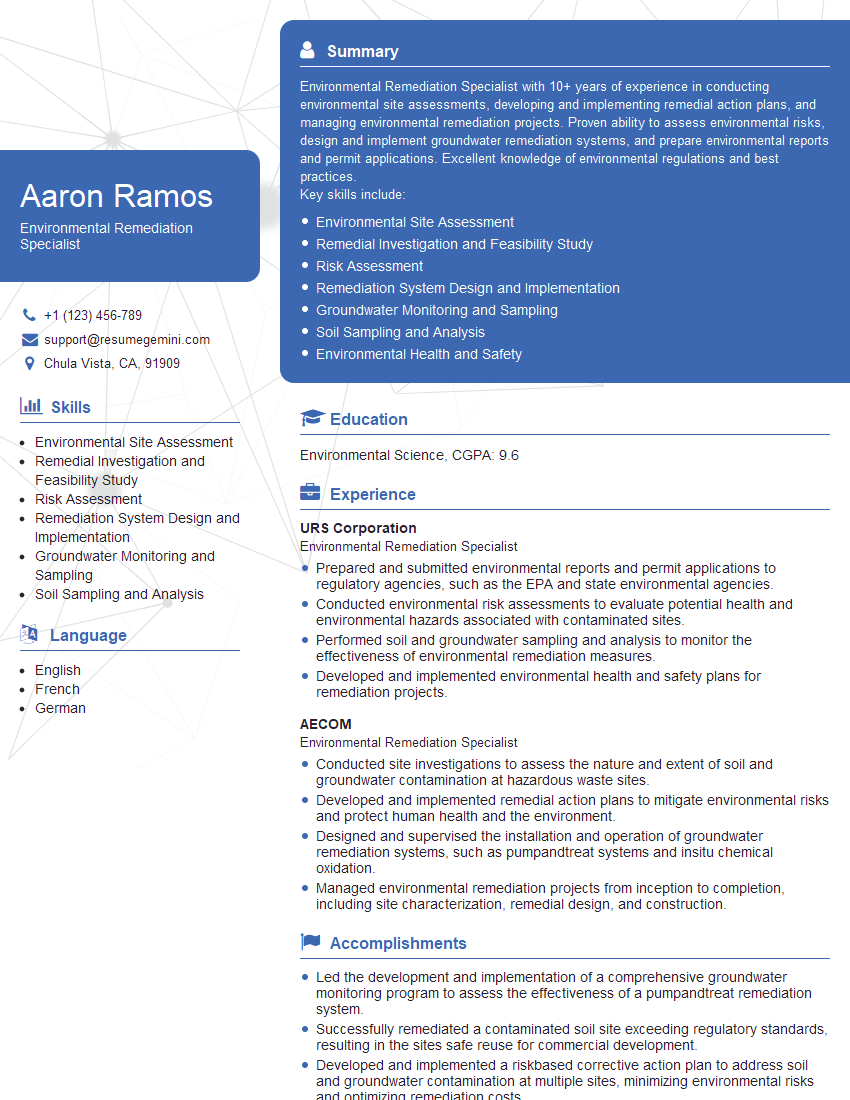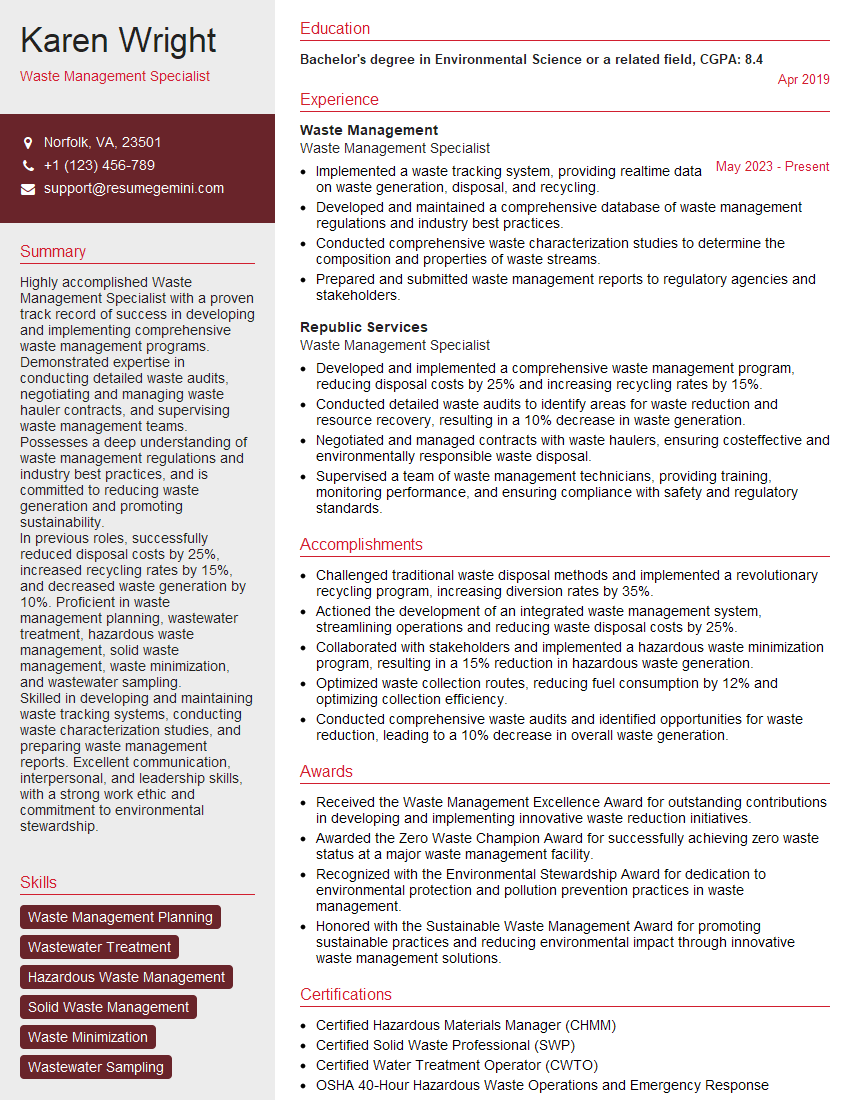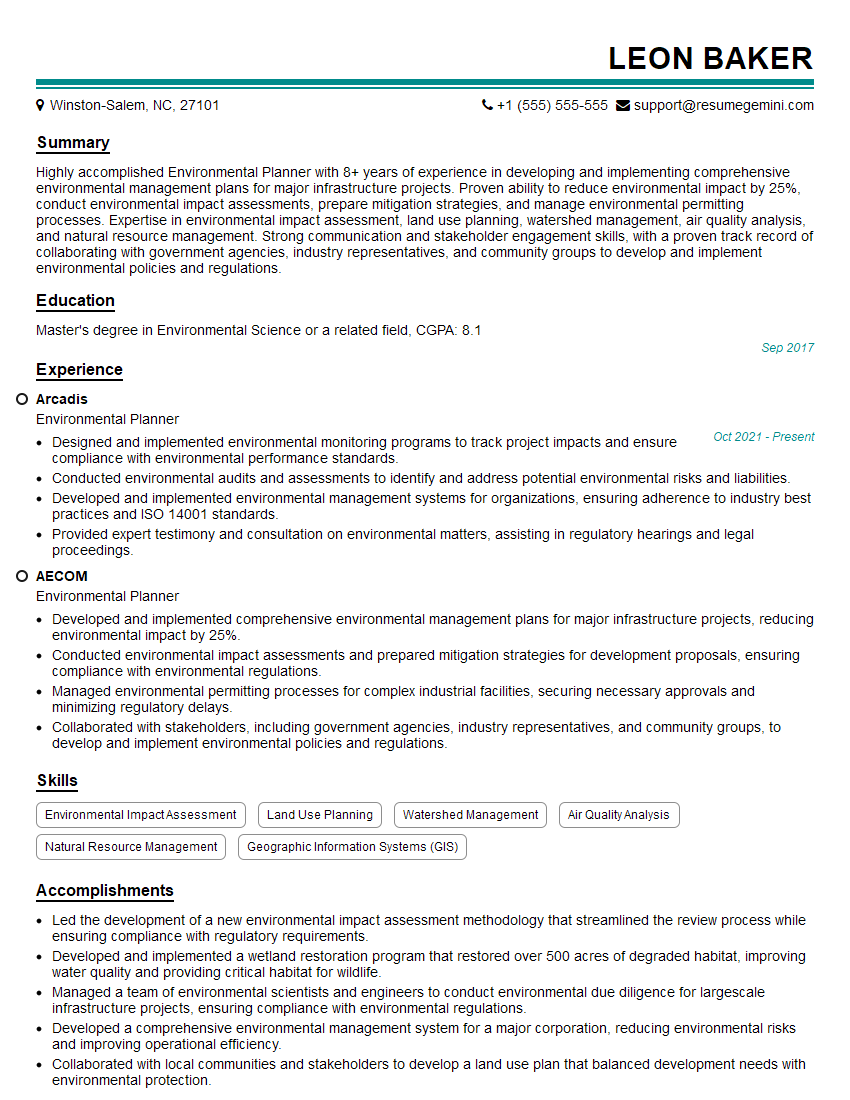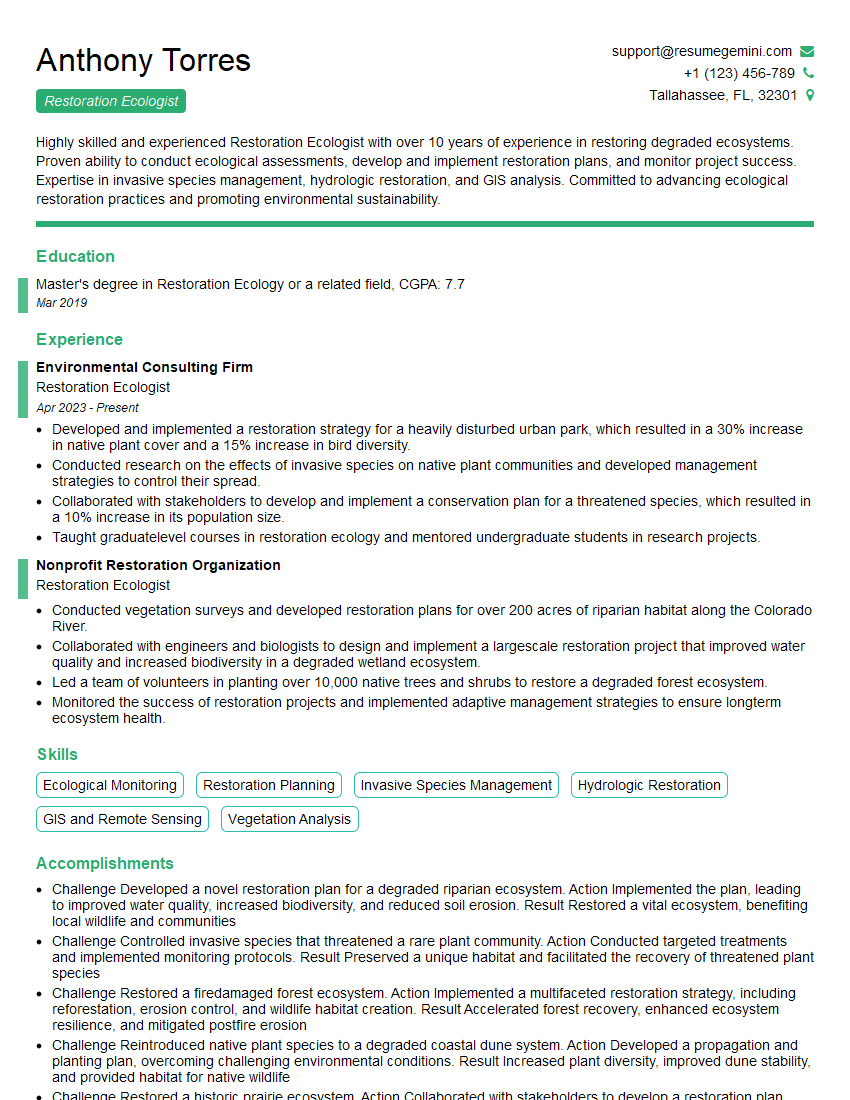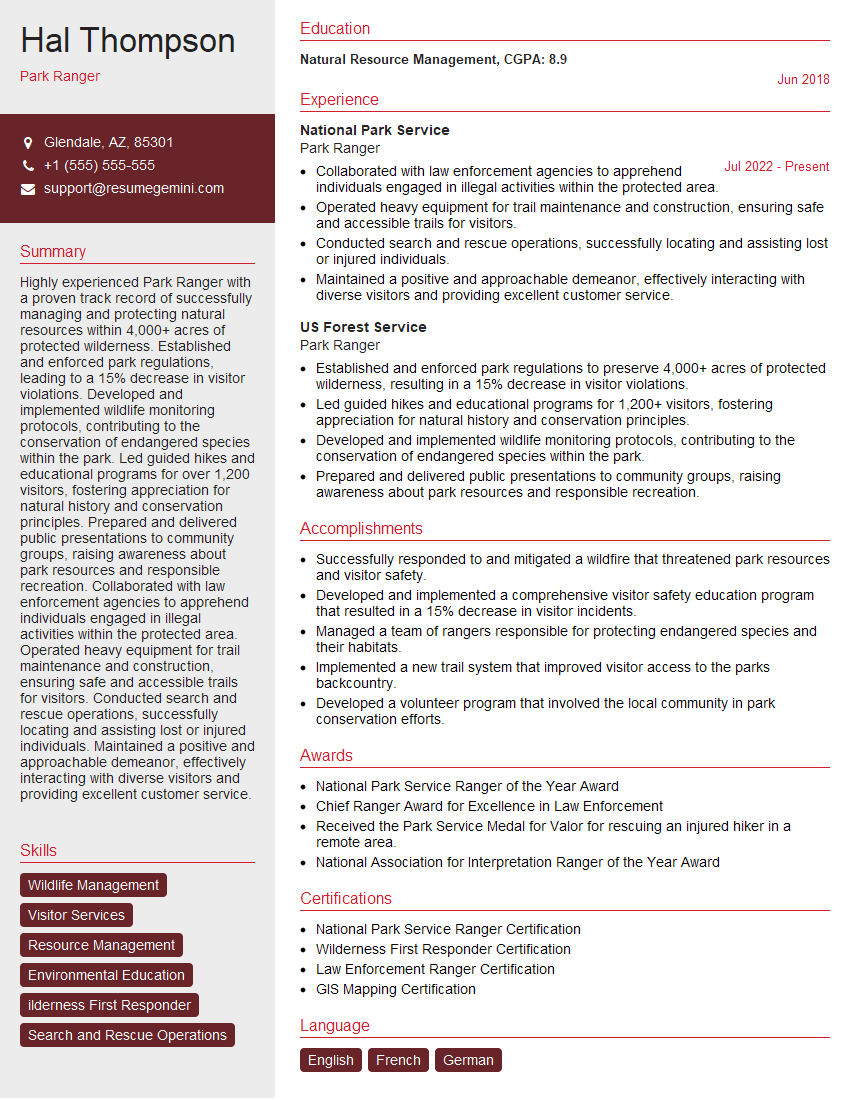Preparation is the key to success in any interview. In this post, we’ll explore crucial Environmental Conservation and Restoration interview questions and equip you with strategies to craft impactful answers. Whether you’re a beginner or a pro, these tips will elevate your preparation.
Questions Asked in Environmental Conservation and Restoration Interview
Q 1. Describe your experience with habitat restoration techniques.
My experience in habitat restoration spans over a decade, encompassing diverse projects from wetland revitalization to forest regeneration. I’ve employed a range of techniques tailored to specific ecosystem needs. For instance, in a wetland restoration project, we utilized bioengineering techniques such as planting native wetland species like cattails and sedges to stabilize the banks and improve water quality. These plants help filter pollutants and provide habitat for wildlife. In a forest restoration project following a wildfire, we focused on seeding and planting native tree species, removing invasive plants, and controlling erosion. We also implemented controlled burns to manage undergrowth and promote biodiversity. In both instances, careful site assessment, species selection, and monitoring were crucial for success. My work has involved collaboration with landowners, government agencies, and community volunteers, emphasizing the importance of community engagement for long-term project success.
- Techniques Used: Bioengineering, seeding, planting, invasive species removal, erosion control, prescribed burning, hydrological restoration.
- Ecosystems Restored: Wetlands, forests, grasslands.
Q 2. Explain the principles of ecological succession.
Ecological succession is the gradual process of change in species composition within a community over time. Think of it like a relay race where different plant and animal communities take their turn dominating an area. It’s driven by the interplay of biotic factors (living organisms) and abiotic factors (climate, soil, etc.). There are two main types: primary and secondary succession.
- Primary Succession: This starts in areas devoid of life, like bare rock after a volcanic eruption. Pioneer species, such as lichens and mosses, are the first to colonize, slowly breaking down the rock and creating soil. Over centuries, more complex communities develop.
- Secondary Succession: This occurs after a disturbance in an existing ecosystem, like a forest fire or clear-cutting. The soil remains, allowing for a faster recovery, with existing seeds and root systems playing a vital role. We often work to speed up secondary succession during restoration efforts.
Understanding succession is crucial for restoration because it guides our approach. We aim to facilitate the natural progression towards a desired climax community (a relatively stable community), taking into account the timeline and potential for resilience to future disturbances.
Q 3. What are the key challenges in managing invasive species?
Managing invasive species presents significant challenges. Their rapid spread, adaptability, and lack of natural predators often outpace control efforts. Key challenges include:
- Identification and Early Detection: Early detection is crucial. However, many invasive species can be difficult to identify, requiring specialized knowledge and effective monitoring programs.
- Control Methods: Effective control requires a multi-pronged approach, often combining mechanical, chemical, and biological methods. However, each approach has its limitations and potential environmental drawbacks. For example, herbicides can harm non-target species, and biological control agents may themselves become invasive.
- Resource Constraints: Managing invasive species is often resource-intensive, requiring substantial funding, manpower, and expertise. Funding is often insufficient and expertise can be limited in certain areas.
- Public Awareness and Participation: Effective management requires public awareness and cooperation. Education about the impacts of invasive species and how to prevent their spread is essential.
For example, the control of kudzu in the southeastern US has been ongoing for decades, requiring a combination of herbicide application, mechanical removal, and biological controls, yet it remains a persistent problem.
Q 4. How do you assess the environmental impact of a project?
Assessing the environmental impact of a project requires a systematic approach using various tools and techniques. This typically involves conducting an Environmental Impact Assessment (EIA). The EIA process involves:
- Baseline Data Collection: Gathering information about the existing environment, including biodiversity, water quality, air quality, and soil conditions.
- Impact Prediction: Predicting the potential impacts of the project on the environment, both positive and negative, using various models and simulations.
- Mitigation Measures: Developing strategies to minimize or avoid negative impacts and enhance positive impacts. This might involve modifying project design, implementing best management practices, or creating compensatory mitigation areas.
- Monitoring and Evaluation: Monitoring the environmental performance of the project during and after its implementation to assess the effectiveness of the mitigation measures.
For instance, when assessing the impact of a proposed highway, we would analyze its effect on wildlife habitat fragmentation, water quality from runoff, and air quality from increased traffic. Mitigation might include the creation of wildlife crossings or the implementation of stormwater management systems.
Q 5. What methods do you use to monitor environmental remediation efforts?
Monitoring environmental remediation efforts involves a range of methods depending on the specific goals and the nature of the remediation. It is crucial to establish clear monitoring objectives, parameters and a statistically sound sampling design at the outset. We employ both qualitative and quantitative methods.
- Water Quality Monitoring: Measuring parameters like pH, dissolved oxygen, nutrient levels, and the presence of pollutants using water samples at various locations and times.
- Soil Monitoring: Analyzing soil samples for the presence of contaminants, assessing soil health indicators like organic matter content and nutrient levels.
- Biological Monitoring: Assessing the abundance and diversity of plant and animal species to gauge the recovery of the ecosystem. This might involve species surveys, vegetation mapping, or benthic macroinvertebrate sampling in aquatic systems.
- Remote Sensing: Using satellite imagery or aerial photography to monitor changes in land cover, vegetation health, and other environmental parameters over time.
Data collected through these methods are analyzed to determine the effectiveness of remediation efforts and to identify areas needing adjustments. The frequency of monitoring is often adjusted based on initial results and the speed of recovery.
Q 6. Explain your understanding of water resource management.
Water resource management encompasses the sustainable and equitable use of water resources to meet human needs and protect the environment. It requires a holistic approach considering multiple factors, including:
- Water Availability and Demand: Assessing the amount of water available in a region and matching it with the demands from various sectors like agriculture, industry, and domestic use.
- Water Quality: Protecting water sources from pollution through effective wastewater treatment, controlling non-point source pollution (such as runoff from agriculture), and implementing watershed management practices.
- Water Allocation: Developing strategies for fairly allocating water among competing users, considering environmental flow requirements and water rights.
- Water Infrastructure: Planning, developing, and maintaining efficient and sustainable water infrastructure, including dams, reservoirs, pipelines, and irrigation systems.
- Climate Change Adaptation: Addressing the impacts of climate change on water resources, such as changes in precipitation patterns, increased droughts, and sea-level rise.
Effective water resource management often involves integrated water resource management (IWRM), a collaborative approach involving stakeholders from various sectors to develop sustainable water management plans. For example, IWRM might incorporate water conservation measures, rainwater harvesting, and improved irrigation techniques to reduce water demand in agriculture.
Q 7. Describe your experience with GIS software in environmental applications.
I have extensive experience using Geographic Information Systems (GIS) software in environmental applications. GIS allows me to spatially analyze environmental data, create maps, and integrate information from various sources. I utilize GIS for tasks such as:
- Habitat Mapping and Analysis: Creating detailed maps of different habitats and analyzing their spatial relationships to better understand ecosystem connectivity and vulnerability to disturbances.
Example: Using ArcGIS to overlay habitat suitability models with land-use data to identify areas suitable for wildlife corridors. - Invasive Species Mapping: Tracking the spread of invasive species and planning control strategies based on spatial patterns.
Example: Using QGIS to visualize the distribution of an invasive plant and prioritize control efforts in high-density areas. - Environmental Monitoring: Integrating data from various monitoring sources (e.g., water quality sensors, species surveys) to create visualizations of environmental conditions over time.
Example: creating time series maps in a GIS to show the changes in water quality in a river after a remediation project. - Environmental Impact Assessment: Modeling the potential environmental impacts of projects, such as road construction or development, on various environmental parameters.
Example: Using spatial analysis tools in ArcGIS to predict the extent of habitat loss from a proposed development project.
My proficiency in GIS software significantly enhances my ability to analyze complex spatial patterns, create effective visualizations, and communicate environmental data in a clear and understandable manner.
Q 8. How do you prioritize competing conservation goals?
Prioritizing competing conservation goals requires a systematic approach. It’s rarely a simple matter of choosing one over another; instead, it involves careful consideration of various factors, often using a multi-criteria decision analysis (MCDA). This involves identifying all relevant goals, assigning weights based on their importance (considering factors such as biodiversity value, ecosystem services, threat levels, and feasibility), and then evaluating each goal’s potential impact using quantitative and qualitative data. For instance, prioritizing habitat restoration for an endangered species might necessitate temporarily neglecting a less critical, though still important, project like invasive species control in a less sensitive area. The decision-making process should be transparent and involve stakeholders to ensure fairness and buy-in.
A useful framework could involve:
- Identifying goals: Listing all conservation goals, including short-term and long-term objectives.
- Assessing importance: Assigning weights to each goal based on scientific evidence and societal values. This could involve expert elicitation, stakeholder surveys, or cost-benefit analysis.
- Evaluating trade-offs: Analyzing the potential benefits and drawbacks of prioritizing one goal over another. Consider using tools like cost-effectiveness analysis or multi-criteria decision analysis software.
- Implementing and monitoring: Putting the chosen plan into action and monitoring its progress. Adaptive management principles should be applied, adjusting the strategy as needed based on monitoring results.
For example, in a watershed restoration project, I might prioritize water quality improvement to protect endangered fish species over immediate riparian habitat planting if the water quality issue poses an immediate, more significant threat to the species’ survival.
Q 9. What are the different types of pollution and their remediation strategies?
Pollution comes in many forms, each requiring specific remediation strategies. Broadly, we can categorize pollution as:
- Air Pollution: Sources include industrial emissions, vehicle exhaust, and wildfires. Remediation strategies involve implementing stricter emission standards, promoting renewable energy, investing in pollution control technologies (e.g., scrubbers), and improving public transportation.
- Water Pollution: Sources include industrial discharge, agricultural runoff, sewage, and plastic waste. Remediation involves implementing wastewater treatment plants, controlling agricultural runoff through best management practices (BMPs), cleaning up polluted waterways, and reducing plastic consumption.
- Soil Pollution: Sources include industrial waste, agricultural chemicals, and mining activities. Remediation involves bioremediation (using microorganisms to break down pollutants), phytoremediation (using plants to absorb pollutants), soil washing, and landfilling of contaminated soil.
- Noise Pollution: Sources include transportation, construction, and industrial activities. Remediation involves implementing noise barriers, enforcing noise regulations, and promoting quieter technologies.
- Light Pollution: Excessive artificial light at night. Remediation involves using shielded lighting, promoting dark-sky initiatives, and reducing unnecessary outdoor lighting.
Remediation strategies often require a multi-pronged approach, combining various techniques based on the type and severity of pollution, the specific site conditions, and available resources. For example, cleaning up an oil spill might involve physical removal of oil, the use of dispersants, and bioremediation using oil-degrading bacteria.
Q 10. How do you ensure compliance with environmental regulations?
Ensuring compliance with environmental regulations is paramount. This involves a proactive and multi-faceted approach. Firstly, thorough understanding of the relevant legislation is crucial. This includes national and international environmental laws, permits, and standards applicable to the specific project or activity. Secondly, detailed environmental impact assessments (EIAs) are conducted to anticipate potential environmental consequences and design mitigation measures to ensure compliance.
Ongoing monitoring and reporting are equally important. This includes regular environmental monitoring (air, water, soil quality) to track pollution levels and compliance with discharge limits. Detailed records are meticulously maintained to document all activities, monitoring data, and any deviations from permitted operations. These data form the basis of compliance reports submitted to regulatory agencies. Proactive communication and collaboration with regulatory agencies are also vital, seeking clarifications and addressing concerns promptly. A culture of compliance must be fostered within organizations. Regular training programs are essential to keep staff updated on the latest regulations and best practices.
If a non-compliance event occurs, rapid action is necessary. This involves immediate investigation, implementing corrective measures, and reporting the incident to the regulatory agency. A comprehensive corrective action plan should address root causes and prevent future recurrences. This ensures that future projects are carried out within regulatory boundaries and reduces the risk of penalties, reputational damage, and legal action.
Q 11. What are the ethical considerations in environmental conservation?
Ethical considerations in environmental conservation are central to ensuring responsible and sustainable practices. Key ethical considerations include:
- Intergenerational Equity: Protecting the environment for future generations; current actions should not compromise the ability of future generations to meet their own needs.
- Environmental Justice: Ensuring that environmental risks and benefits are equitably distributed among all societal groups, addressing disproportionate impacts on marginalized communities.
- Precautionary Principle: Taking preventive action in the face of uncertainty, particularly when the potential environmental harm is significant.
- Intrinsic Value of Nature: Recognizing that nature has value independent of its usefulness to humans.
- Biodiversity Conservation: Protecting the full range of species and ecosystems, acknowledging the interconnectedness of life on Earth.
For example, the ethical implications of a dam construction project could involve careful assessment of impacts on downstream communities, endangered species, and overall ecosystem health. A truly ethical project would involve thorough consultations, fair compensation for affected communities, and mitigation measures that effectively minimize negative impacts.
Q 12. Explain your understanding of sustainable development principles.
Sustainable development is about meeting the needs of the present without compromising the ability of future generations to meet their own needs. It integrates economic growth, social equity, and environmental protection. Key principles include:
- Environmental Protection: Conserving natural resources, protecting biodiversity, and minimizing pollution.
- Economic Viability: Promoting economic growth that is environmentally sound and socially equitable.
- Social Equity: Ensuring that all people have access to resources and opportunities, reducing poverty and inequality.
- Precautionary Approach: Avoiding actions that may cause irreversible environmental harm.
- Integration of Environmental and Economic Concerns: Addressing environmental challenges within the context of economic decision-making.
- Community Participation: Involving local communities in decision-making processes affecting their environment and livelihoods.
A practical example of sustainable development is the use of renewable energy sources such as solar and wind power. This approach promotes economic development through job creation and reduced reliance on fossil fuels, while simultaneously protecting the environment by reducing greenhouse gas emissions. Furthermore, investments in renewable energy technologies can contribute to social equity by providing access to clean and affordable energy in underserved communities.
Q 13. Describe your experience with community engagement in conservation projects.
Community engagement is critical for successful conservation projects. My experience involves various strategies, from participatory mapping exercises where communities identify key ecological areas and prioritize conservation actions, to co-designing restoration projects based on local ecological knowledge and practical needs. I’ve led workshops and facilitated dialogues to build consensus and address concerns. This ensures the project respects local customs and values and secures the long-term support of the community.
For example, in a coastal ecosystem restoration project, we worked directly with local fishing communities to understand their traditional practices and concerns. By incorporating their knowledge and feedback, we co-designed a restoration plan that balanced environmental protection with the needs of the fishing industry. This collaborative approach enhanced project effectiveness and ensured community buy-in, leading to better long-term outcomes.
Effective communication is crucial. Using accessible language, regular updates, and creating opportunities for feedback are vital. Involving local leaders and community organizations builds trust and facilitates communication. Building trust takes time and consistent effort. Demonstrating tangible benefits to the community and sharing successes reinforces trust and encourages continued engagement.
Q 14. How do you handle conflicting stakeholder interests in conservation planning?
Handling conflicting stakeholder interests requires a facilitative approach prioritizing open communication, transparency, and collaborative problem-solving. The process begins with identifying all stakeholders and understanding their interests and concerns. This can involve stakeholder mapping, surveys, interviews, and public forums. Once identified, we work towards mapping out different viewpoints and needs. Neutral facilitation helps stakeholders articulate their positions, identify common ground, and explore potential compromises.
Techniques such as mediation and negotiation can be employed to help find mutually acceptable solutions. Prioritizing transparent communication and information sharing ensures that decisions are well-informed and based on scientific data and community values. A collaborative approach that respects all perspectives allows for co-creation of solutions that address multiple needs. It’s important to realize that not all conflicts can be fully resolved, but we can work to create a more equitable solution for all. For example, a conservation plan that includes both habitat protection and sustainable forestry might balance the needs of environmentalists with those of the logging industry, creating a compromise that serves both needs. Ultimately, achieving a balance among competing interests often requires creative solutions that consider long-term sustainability while addressing the immediate needs of different groups.
Q 15. What are the key indicators of a healthy ecosystem?
A healthy ecosystem is a vibrant and resilient community of living organisms and their physical environment, interacting in a balanced and sustainable way. Key indicators are multifaceted, but generally fall under these categories:
- Biodiversity: A high number of different species across various trophic levels (producers, consumers, decomposers) is a hallmark of a healthy ecosystem. For example, a rainforest with a vast array of plant and animal life is far healthier than a monoculture farm.
- Abundance and Distribution: Healthy populations of key species, appropriately distributed across the habitat, signify ecosystem health. If a keystone species – one with a disproportionately large impact on the ecosystem – is declining, it’s a significant warning sign. For instance, the decline of sea otters in kelp forests can lead to a devastating collapse of the whole ecosystem.
- Nutrient Cycling: Efficient cycling of essential nutrients like nitrogen and phosphorus is crucial. A healthy ecosystem efficiently breaks down organic matter, releasing nutrients back into the soil or water, supporting plant growth and overall productivity. A bog, for instance, exhibits very slow nutrient cycling compared to a temperate forest.
- Water Quality: Clean water, with appropriate oxygen levels and minimal pollution, is fundamental. The presence of indicator species (like certain types of aquatic insects) can help assess water quality. For instance, mayflies are very sensitive to pollution, their absence points to poor water quality.
- Resilience: The ability of an ecosystem to recover from disturbances like fire or drought. This indicates its overall robustness and stability. A coral reef that recovers quickly from a bleaching event is more resilient than one that takes years to recover.
These indicators are interconnected; changes in one area often impact others. Monitoring multiple indicators provides a comprehensive assessment of ecosystem health.
Career Expert Tips:
- Ace those interviews! Prepare effectively by reviewing the Top 50 Most Common Interview Questions on ResumeGemini.
- Navigate your job search with confidence! Explore a wide range of Career Tips on ResumeGemini. Learn about common challenges and recommendations to overcome them.
- Craft the perfect resume! Master the Art of Resume Writing with ResumeGemini’s guide. Showcase your unique qualifications and achievements effectively.
- Don’t miss out on holiday savings! Build your dream resume with ResumeGemini’s ATS optimized templates.
Q 16. Explain your experience with data analysis in environmental research.
My experience with data analysis in environmental research is extensive. I’ve utilized various statistical methods and software packages, such as R and ArcGIS, to analyze diverse datasets, including:
- Spatial data: Analyzing remotely sensed imagery (e.g., satellite data) to map habitat change, deforestation rates, and species distribution. For example, I used satellite imagery to monitor the expansion of agricultural land into a protected rainforest.
- Temporal data: Analyzing time series data (e.g., long-term monitoring of water quality, air pollution levels, population counts) to identify trends, patterns, and impacts of environmental changes. In one project, we used time series analysis to demonstrate the effects of pollution on a declining salmon population.
- Experimental data: Analyzing data from controlled experiments to assess the effectiveness of restoration techniques or the impact of pollutants on ecosystems. For example, we used statistical modeling to compare the success of different wetland restoration methods.
My analytical skills extend to data visualization, creating informative graphs and maps to communicate complex environmental data effectively to both scientific and public audiences. I am also experienced in using statistical software for modelling and forecasting future scenarios. I am proficient in statistical analysis, including hypothesis testing, regression analysis, and geospatial statistics.
Q 17. How do you develop and implement a conservation plan?
Developing and implementing a conservation plan is a multi-step process requiring careful planning and stakeholder engagement. The process typically involves:
- Assessment: Thoroughly assessing the current state of the ecosystem, identifying key threats, and determining conservation goals. This often involves field surveys, literature reviews, and stakeholder consultations.
- Goal Setting: Setting SMART (Specific, Measurable, Achievable, Relevant, Time-bound) goals and objectives that are aligned with the overall conservation aims. This may include target population sizes, habitat restoration targets, or pollution reduction goals.
- Strategy Development: Identifying and prioritizing actions that will effectively address the key threats and achieve the set goals. This may involve habitat restoration, species reintroduction, pollution control, education, or community engagement.
- Implementation: Putting the plan into action, which may involve on-the-ground work, policy changes, community initiatives, or funding acquisition.
- Monitoring and Evaluation: Regularly monitoring the progress of the plan and evaluating its effectiveness. This involves collecting data, analyzing results, and adapting the plan as needed.
- Adaptive Management: Continuously monitoring and adjusting the plan based on new information, unexpected changes, and evaluation results. Conservation is a dynamic field, and plans must adapt to new challenges and opportunities.
A successful conservation plan considers ecological, social, and economic factors and involves collaboration among scientists, policymakers, and local communities.
Q 18. What are your strategies for managing environmental risks?
Managing environmental risks involves proactive strategies to prevent or mitigate potential harm to ecosystems. My strategies include:
- Risk Assessment: Identifying potential environmental risks, such as pollution, habitat loss, invasive species, or climate change impacts. This often involves using risk matrices to prioritize threats based on their likelihood and potential consequences.
- Prevention: Implementing measures to prevent environmental risks from occurring in the first place. This might include implementing sustainable land management practices, preventing pollution through stricter regulations, or controlling invasive species.
- Mitigation: Reducing the severity of environmental risks if they do occur. This may involve implementing restoration techniques to rehabilitate degraded ecosystems, or developing contingency plans to manage environmental disasters like oil spills.
- Monitoring and Early Warning Systems: Establishing monitoring programs to detect environmental problems early on, allowing for timely intervention. This might involve water quality monitoring, wildlife surveys, or early warning systems for natural disasters.
- Community Engagement: Educating and empowering local communities to participate in environmental risk management. Involving communities fosters a sense of stewardship and promotes sustainable practices.
A robust risk management plan requires ongoing adaptation as new risks emerge and conditions change. Using a combination of these strategies fosters resilience in the face of environmental challenges.
Q 19. Describe your experience with environmental impact assessments.
I have extensive experience conducting Environmental Impact Assessments (EIAs). EIAs are systematic processes used to identify, predict, evaluate, and mitigate the environmental impacts of proposed projects. My involvement typically includes:
- Scoping: Defining the scope of the EIA, identifying the potential environmental impacts, and determining the appropriate level of detail required.
- Baseline Studies: Conducting field surveys and data analysis to establish the existing environmental conditions before the project commences.
- Impact Prediction: Using various modeling techniques and expert judgment to predict the potential environmental impacts of the project, both positive and negative.
- Impact Evaluation: Assessing the significance of the predicted impacts, considering factors such as magnitude, duration, and irreversibility.
- Mitigation Measures: Developing and recommending strategies to mitigate or avoid significant adverse environmental impacts.
- Reporting: Preparing comprehensive EIA reports that clearly communicate the findings and recommendations to stakeholders.
I have experience across diverse sectors, including infrastructure development, mining, and energy projects. My EIAs have ensured projects are implemented in an environmentally responsible manner, minimizing their footprint and maximizing their ecological benefits.
Q 20. Explain your understanding of climate change impacts on ecosystems.
Climate change is profoundly impacting ecosystems worldwide. The primary impacts include:
- Shifting Species Distributions: As temperatures rise and precipitation patterns change, many species are shifting their ranges towards higher altitudes or latitudes in search of suitable habitats. This can lead to species extinctions and disruptions in ecosystem interactions.
- Changes in Phenology: The timing of seasonal events, such as migration, flowering, and breeding, is shifting. Mismatches in the timing of these events can disrupt ecological relationships, for example, between pollinators and plants.
- Increased Frequency and Intensity of Extreme Weather Events: More frequent and severe droughts, floods, heatwaves, and wildfires are causing widespread damage to ecosystems and leading to habitat loss.
- Ocean Acidification: The absorption of excess atmospheric CO2 by the oceans is causing ocean acidification, threatening marine organisms, particularly those with calcium carbonate shells or skeletons, like corals and shellfish.
- Sea Level Rise: Rising sea levels are inundating coastal ecosystems, such as mangroves and salt marshes, leading to habitat loss and displacement of species.
These impacts interact and cascade, creating complex challenges for conservation efforts. Understanding these impacts is vital for developing effective climate change adaptation strategies.
Q 21. How do you adapt conservation strategies to climate change?
Adapting conservation strategies to climate change requires a proactive and integrated approach. Key strategies include:
- Protected Area Management: Expanding and improving the management of protected areas to account for climate change impacts, allowing for species migration and habitat shifts. This might involve creating ecological corridors or establishing climate refugia.
- Assisted Migration: Relocating species to areas with more suitable climates in response to changing conditions, while carefully considering potential risks and ecological consequences.
- Habitat Restoration and Enhancement: Restoring degraded habitats to enhance ecosystem resilience to climate change and creating more climate-resilient ecosystems. For instance, planting drought-resistant tree species in forests.
- Species Conservation: Focusing conservation efforts on species that are particularly vulnerable to climate change, including genetic conservation, habitat management, and captive breeding programs.
- Community Engagement and Education: Engaging local communities in climate change adaptation strategies, such as promoting sustainable land management practices and raising awareness about climate change impacts.
- Policy and Governance: Implementing policies that support climate change adaptation, such as carbon emission reduction targets, sustainable resource management, and incentives for climate-friendly practices.
Adapting conservation strategies is an iterative process that requires ongoing monitoring, evaluation, and adjustment based on new scientific knowledge and changing conditions. A collaborative and adaptive approach is critical for success.
Q 22. Describe your experience with biodiversity conservation.
My experience in biodiversity conservation spans over a decade, encompassing both fieldwork and policy-level engagement. I’ve been involved in numerous projects focused on habitat restoration, species monitoring, and community-based conservation initiatives. For example, I led a team that successfully restored a degraded wetland area, resulting in a 30% increase in bird species diversity within two years. This involved not only the physical restoration of the wetland but also community education programs to promote long-term stewardship. Another significant project involved developing and implementing a conservation plan for an endangered butterfly species, focusing on habitat connectivity and the mitigation of threats from agricultural practices. This required collaborating with local farmers and landowners to implement sustainable land management techniques.
Q 23. What are the different types of protected areas and their management strategies?
Protected areas are crucial for biodiversity conservation. They represent a spectrum of management approaches, reflecting varying degrees of human impact and conservation goals.
- Strict Nature Reserves: These areas prioritize biodiversity protection with minimal human interference. Think pristine wilderness areas where scientific research and monitoring are the primary activities.
- National Parks: These areas balance conservation with recreation and tourism, offering opportunities for visitors to experience nature while adhering to regulations to minimize environmental impact. Yellowstone National Park is a prime example.
- Natural Monuments: These focus on the protection of specific natural features, like unique geological formations or significant trees, often smaller in scale than parks or reserves.
- Habitat/Species Management Areas: These areas actively manage habitats to sustain particular species or ecosystems. This could involve controlled burning, invasive species removal, or habitat restoration.
- Protected Landscapes/Seascapes: These areas combine conservation with sustainable resource use. They often involve local communities in management, balancing ecological integrity with economic needs.
- Protected Areas with Sustainable Use of Natural Resources: This category allows for the sustainable harvesting of natural resources, such as timber or fisheries, while still maintaining biodiversity.
Management strategies vary depending on the type of protected area and its specific goals. Common approaches include habitat restoration, invasive species control, monitoring biodiversity trends, law enforcement, education and community engagement, and sustainable resource management. Effective management requires adaptive strategies, continually adjusting to changing environmental conditions and societal needs.
Q 24. How do you communicate complex environmental information to diverse audiences?
Communicating complex environmental information effectively requires tailoring your approach to the audience. I use a variety of methods, starting with understanding my audience’s prior knowledge and their interests. For example, when presenting to scientists, I use technical language and detailed data. However, when communicating with the general public, I focus on storytelling, visual aids, and simple analogies. I often use metaphors and real-world examples to make complex concepts relatable. For instance, explaining carbon sequestration by comparing it to a sponge absorbing water can be more effective than a detailed scientific explanation. Interactive workshops, citizen science initiatives, and the use of social media platforms also play a critical role in engaging diverse audiences.
Q 25. What are your strengths and weaknesses in environmental conservation?
My strengths lie in my analytical skills, my ability to collaborate effectively with diverse teams, and my passion for finding innovative solutions to environmental problems. I excel at synthesizing complex information and translating it into actionable strategies. I’m also a strong communicator, able to bridge the gap between scientific research and public understanding. A weakness I’m actively working on is delegating tasks efficiently. While I thrive on being involved in every aspect of a project, I recognize the importance of empowering team members and trusting their expertise. I’m actively developing my leadership skills to improve in this area.
Q 26. Describe a time you had to solve a complex environmental problem.
During a project aimed at restoring a polluted river, we faced a complex challenge. The pollution stemmed from multiple sources—industrial discharge, agricultural runoff, and inadequate sewage treatment. Our initial plan focused on a single source, but it proved ineffective. We realized a holistic approach was needed. The solution involved a multi-pronged strategy: collaborating with local industries to upgrade their waste treatment systems, working with farmers to implement sustainable agricultural practices, and advocating for improved municipal sewage infrastructure. We also engaged local communities through educational programs and volunteer clean-up events. By addressing the problem from multiple angles, we successfully reduced pollution levels significantly and improved river health, demonstrating the importance of systemic thinking in environmental problem-solving.
Q 27. How do you stay updated on the latest advancements in environmental science?
Staying updated in environmental science requires a multi-faceted approach. I regularly read peer-reviewed scientific journals like Science and Nature. I attend conferences and workshops to network with colleagues and learn about the latest research findings. I actively participate in online communities and forums related to environmental conservation, engaging in discussions and learning from experts in the field. I also follow reputable environmental organizations and government agencies that publish reports and data on environmental issues. This combination of formal and informal learning ensures I maintain a current understanding of advancements in the field.
Q 28. What are your career aspirations in environmental conservation?
My career aspirations involve leveraging my expertise to contribute to large-scale environmental conservation initiatives. I aim to lead projects that integrate scientific research with policy-making and community engagement, focusing on climate change mitigation and adaptation, biodiversity conservation, and sustainable resource management. Ultimately, I hope to play a significant role in shaping environmentally sustainable policies and practices that benefit both ecosystems and human societies.
Key Topics to Learn for Environmental Conservation and Restoration Interview
- Ecosystem Dynamics: Understanding the intricate relationships within ecosystems, including energy flow, nutrient cycling, and species interactions. Practical application: Analyzing the impact of a proposed development on a local wetland ecosystem.
- Habitat Restoration Techniques: Familiarize yourself with various methods for restoring degraded habitats, including reforestation, wetland creation, and invasive species removal. Practical application: Designing a restoration plan for a polluted river system.
- Pollution Control and Remediation: Explore strategies for mitigating different types of pollution (air, water, soil) and the technologies used for remediation. Practical application: Evaluating the effectiveness of different approaches to clean up a contaminated site.
- Conservation Biology Principles: Understand core concepts like biodiversity, endangered species management, and protected area design. Practical application: Developing a conservation plan for a threatened bird species.
- Environmental Impact Assessment (EIA): Learn the process of conducting EIAs, identifying potential environmental impacts of projects, and proposing mitigation measures. Practical application: Assessing the environmental consequences of a proposed wind farm.
- Sustainable Resource Management: Explore principles of sustainable forestry, fisheries, and agriculture, considering ecological, social, and economic factors. Practical application: Developing a plan for sustainable timber harvesting in a forest.
- Climate Change Adaptation and Mitigation: Understand the impacts of climate change on ecosystems and the strategies for adapting to and mitigating these impacts. Practical application: Designing a climate resilience plan for a coastal community.
- Data Analysis and Interpretation: Develop skills in analyzing environmental data (e.g., water quality, biodiversity surveys) and interpreting the results. Practical application: Using statistical analysis to determine the effectiveness of a restoration project.
- Environmental Policy and Legislation: Familiarize yourself with relevant environmental laws and regulations at local, national, and international levels. Practical application: Analyzing the implications of a new environmental policy on a specific industry.
Next Steps
Mastering Environmental Conservation and Restoration opens doors to a rewarding career with significant impact. To maximize your job prospects, creating a compelling and ATS-friendly resume is crucial. ResumeGemini is a trusted resource that can help you build a professional resume tailored to highlight your skills and experience in this competitive field. Examples of resumes specifically designed for Environmental Conservation and Restoration professionals are available to guide your process.
Explore more articles
Users Rating of Our Blogs
Share Your Experience
We value your feedback! Please rate our content and share your thoughts (optional).
What Readers Say About Our Blog
Hi, I represent an SEO company that specialises in getting you AI citations and higher rankings on Google. I’d like to offer you a 100% free SEO audit for your website. Would you be interested?
good

